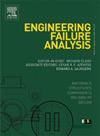基于全尺寸试验台的中低速磁悬浮车辆悬浮架结构强度研究
IF 4.4
2区 工程技术
Q1 ENGINEERING, MECHANICAL
引用次数: 0
摘要
悬浮架的结构强度对中低速磁悬浮列车的安全运行至关重要。本文将理论计算、动态模拟和有限元分析相结合,确定悬浮框架的边界载荷,识别薄弱环节,计算累积损伤。建立了全尺寸强度试验台,利用第四强度理论和修正的Goodman-Smith (GS)图对静强度和疲劳强度进行了评估,并通过疲劳试验和无损检测进行了验证。结果表明:在紧急着陆制动工况下,驻车制动滑块处的峰值应力为67.22 MPa,低于材料的屈服极限;高应力主要集中在承载接触面积较小的条件下。应力分析表明,应力幅值和平均应力分布在GS图的中心区域,且应力幅值影响显著,揭示了动载荷对疲劳强度的重要影响。从有限元分析和台架试验中观察到关键区域和应力分布之间的良好一致性。累积损伤分析表明,焊缝区域损伤高于母材,牵引杆座角焊缝的最大累积损伤为0.19。疲劳试验后无损检测未发现裂纹。这些结果验证了本研究方法的有效性和准确性。本文章由计算机程序翻译,如有差异,请以英文原文为准。
Research on the structural strength of medium and low speed maglev vehicle levitation frame based on full-scale test bench
The structural strength of the levitation frame is crucial for the safe operation of medium and low speed maglev vehicle. This paper integrates theoretical calculations, dynamic simulations, and finite element analysis (FEA) to determine levitation frame boundary loads, identify weak points, and calculate cumulative damage. A full-scale strength test bench was constructed, and static and fatigue strengths were evaluated using the Fourth Strength Theory and a modified Goodman-Smith (GS) diagram, validated through fatigue tests and non-destructive testing. Results show that under emergency landing brake conditions, the peak stress at the parking brake skid is 67.22 MPa, below the material’s yield limit; high stresses are mainly concentrated in conditions with smaller load-bearing contact areas. Stress analysis indicates that stress amplitude and mean stress are distributed in the central region of the GS diagram, with stress amplitude having a significant impact, revealing the important influence of dynamic loads on fatigue strength. Good agreement is observed between critical areas and stress distributions from FEA and bench tests. Cumulative damage analysis shows higher damage in weld areas than in base material, with a maximum cumulative damage of 0.19 at the traction rod seat fillet weld. Non-destructive testing after fatigue tests found no cracks. These results validate the effectiveness and accuracy of the method presented in this study.
求助全文
通过发布文献求助,成功后即可免费获取论文全文。
去求助
来源期刊

Engineering Failure Analysis
工程技术-材料科学:表征与测试
CiteScore
7.70
自引率
20.00%
发文量
956
审稿时长
47 days
期刊介绍:
Engineering Failure Analysis publishes research papers describing the analysis of engineering failures and related studies.
Papers relating to the structure, properties and behaviour of engineering materials are encouraged, particularly those which also involve the detailed application of materials parameters to problems in engineering structures, components and design. In addition to the area of materials engineering, the interacting fields of mechanical, manufacturing, aeronautical, civil, chemical, corrosion and design engineering are considered relevant. Activity should be directed at analysing engineering failures and carrying out research to help reduce the incidences of failures and to extend the operating horizons of engineering materials.
Emphasis is placed on the mechanical properties of materials and their behaviour when influenced by structure, process and environment. Metallic, polymeric, ceramic and natural materials are all included and the application of these materials to real engineering situations should be emphasised. The use of a case-study based approach is also encouraged.
Engineering Failure Analysis provides essential reference material and critical feedback into the design process thereby contributing to the prevention of engineering failures in the future. All submissions will be subject to peer review from leading experts in the field.
 求助内容:
求助内容: 应助结果提醒方式:
应助结果提醒方式:


